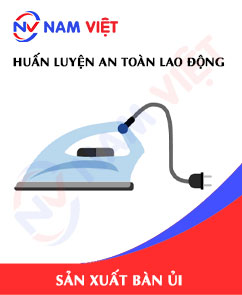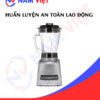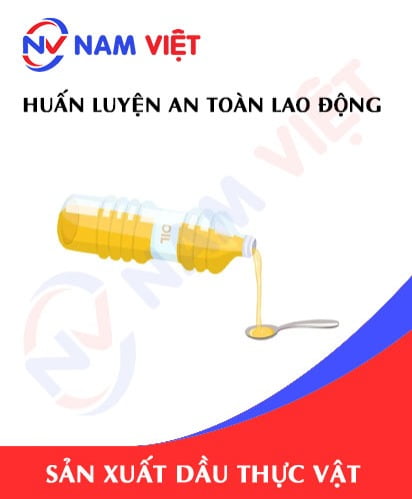Occupational Safety Training in Iron Manufacturing
99,000 ₫
Note: The above price is calculated for one person, and the price may fluctuate depending on the number of trainees participating in the course and market movements. For more accurate pricing support, please refer to the quotation table or contact our consulting staff directly.
Occupational safety is an important issue in iron manufacturing factories and needs to be addressed promptly to ensure the health and safety of workers, while enhancing the reputation of businesses. The Occupational safety training course is one of the effective solutions to raise awareness of accident prevention for workers participating in iron manufacturing.
Table of Contents
Toggle1. Overview of Irons
a. What is an iron?
An iron (also called a flat iron) is an electrical device used to straighten clothes and knitted fabrics. An iron can be heated electrically or with steam and has a flat, smooth surface that helps remove wrinkles from clothes and knitted fabrics.
The iron is an indispensable tool for keeping clothes and knitted fabrics clean and looking neat.

b. Types of machinery for iron production
The machinery used to produce irons includes:
- Metal cutting machines: These are used to precisely cut metal parts for the iron.
- Heat press machines: Used to press materials onto parts of the iron.
- Punching machines: Used to create ventilation holes on the iron.
- Welding machines: Used to weld iron parts together.
- Grinding machines: Used to polish the surface of the iron.
- Spray painting machines: Used to apply a protective coating on the iron’s surface.
- Printing machines: Used to print labels, images, or branding information on the iron.
Depending on the scale and purpose of production, manufacturers may use one or multiple types of machinery during the iron production process.

c. Iron manufacturing companies in Vietnam
Currently, there are many brands producing irons on the market. Some well-known and widely trusted brands include:
- Philips: A famous iron brand produced by Philips, a Dutch multinational electronics and home appliance company. Philips products are highly rated for functionality and durability.
- Panasonic: Founded in 1918, Panasonic is one of the leading brands in electronics and home appliances. Their irons are modern, diverse, and equipped with advanced features.
- Bosch: A German brand established in 1886. With skilled engineers and years of production experience, Bosch irons are highly regarded for quality and durability.
- Tefal: A well-known kitchenware brand that has expanded into iron production. Tefal irons are diverse in design, high quality, and reasonably priced.
- Electrolux: One of the world’s leading home appliance brands based in Sweden. Electrolux irons are highly rated for functionality and modern design.
d. Specific jobs in iron manufacturing factories
Group 1
- Chief Executive Officer, Deputy CEO, department heads in the iron production factory.
Group 2
- Safety officers: manage factory safety, design safety procedures, supervise and ensure workers comply with safe working procedures.
Group 3
- Material selection: Choosing suitable materials for iron components such as the soleplate, base, temperature controller, power cord, buttons, etc.
- Production of soleplates: Soleplates are made from materials such as stainless steel, aluminum, or alloys and processed for flatness and durability.
- Iron assembly: Components are assembled and tested for safety and quality before mass production.
- Quality control: Irons are inspected to ensure they meet customer requirements for functionality, safety, durability, and design.
- Packing and shipping: Products are packaged and prepared for delivery to distributors or retail stores for consumers.
Group 4
- Office, service, sales, and marketing tasks.
- Production management, quality management, human resources, materials management, financial and accounting management.
- Product design: Designing irons to meet customer needs, including functionality, durability, and style.

2. Overview of occupational safety training for iron production
In this article, we focus on Group 3 because Group 3 directly participates in the production process and faces the highest occupational safety risks. For information about other groups, refer here.
a. What is Group 3 occupational safety training?
- Group 3 occupational safety training consists of sessions that equip workers with awareness of how to prevent workplace accidents.
- The training course helps workers recognize and avoid hazards, reducing the risks of accidents during work.
REGISTER FOR OCCUPATIONAL SAFETY TRAINING SERVICE
b. Training duration
Initial safety training duration
- Total training time is at least 24 hours, including exam time.
- 8 hours of theory on safety policies, laws, and occupational hygiene
- 8 hours of theory on basic safety and occupational hygiene knowledge
- 4 hours of theory on specialized training content
- 2 hours of practical training on specialized content
- 2 hours of theory exam at the end of the course
The safety training center will schedule multiple sessions depending on workers’ availability. Typically, there are 6 training sessions, conducted over 3 days if the production company can arrange continuous learning.
Periodic safety training duration
- Before the occupational safety card expires, workers must undergo periodic occupational safety training with a training duration of at least 50% of the initial training time.
Explanation: Total periodic occupational safety training is at least 12 hours, including exam time. After completing the periodic training and passing the test, workers will be reissued and have their occupational safety card renewed.
c. Training content
| No. | TRAINING CONTENT | TRAINING TIME (HOURS) | |||
| Total | Including | ||||
| Theory | Practical | Test | |||
| I | Safety policies, laws, and occupational hygiene | 8 | 8 | 0 | 0 |
| 1 | Overview of the legal framework for occupational safety and hygiene. | 6 | 6 | ||
| 2 | Standards and technical regulations for occupational safety and hygiene. | 1 | 1 | ||
| 3 | Specific regulations from state authorities on safety and hygiene when constructing, expanding, or renovating facilities, and using, storing, or inspecting machinery and materials with strict safety requirements. | 1 | 1 | ||
| II | Basic safety and occupational hygiene knowledge | 8 | 8 | 0 | 0 |
| 1 | Basic knowledge of hazards and harmful factors in the workplace. | 4 | 4 | ||
| 2 | Methods to improve working conditions. | 1 | 1 | ||
| 3 | Safety culture in production and business. | 1 | 1 | ||
| 4 | Rights and obligations of employers and employees; safety policies and regulations; roles and responsibilities of safety and hygiene staff. | 1 | 1 | ||
| 5 | Safety rules, signage, instructions, use of safety equipment, personal protective equipment; first aid skills and occupational disease prevention. | 1 | 1 | ||
| III | Specialized training content | 6 | 4 | 2 | 0 |
| Comprehensive knowledge of machinery, equipment, and substances generating hazards; risk assessment and management; safe working procedures with machinery and substances with strict safety requirements. | 6 | 4 | 2 | ||
| IV | Final safety training assessment | 2 | 2 | 0 | 0 |
| Total | 24 | 22 | 2 | ||
See more training content of the 6 groups
d. Occupational safety card
After completing the occupational safety training and passing the exam, workers will be issued an occupational safety card (commonly called Group 3 safety certificate).
The Group 3 safety card shows the worker’s full name, date of birth, specific job, and work environment. It also includes training duration, red seal, and signature confirming course completion.
According to Clause 2 of Article 24 of Decree 44/2016/ND-CP, there are two cases:
- If the employer and employee have a labor contract, the employer must sign, stamp, and certify the safety card for Group 3 trainees after completing the course from an occupational safety training unit and passing the exam.
- If the worker is freelance or seasonal with no labor contract, the training unit must sign, stamp, and certify the safety card after the worker completes the training and passes the exam.

3. Identifying hazards affecting workers during iron production
During iron production, potential hazards for workers include:
- Risk of burns: Since an iron is a heat-generating device, it can cause burns to workers if they are not properly trained or do not use full protective equipment.
- Risk of UV exposure: Some irons have drying and smoothing functions that use ultraviolet (UV) rays to kill bacteria. Workers must ensure they do not directly contact UV rays to avoid skin and eye damage.
- Risk of puncture injuries: Components such as cutting edges or sliding plates can cause injuries if workers do not wear adequate personal protective equipment, such as protective gloves or safety goggles.
- Risk of occupational accidents: Iron manufacturing machinery operates at high speed and force, so there is a risk of occupational accidents if employees do not follow proper procedures.
- Health risks: Prolonged use of irons can cause back pain and shoulder strain for workers, so protective health measures are necessary.
- Electrical hazards: If electrical equipment in the factory is not regularly maintained, properly insulated, or waterproofed, it may pose an electric shock hazard to workers during production.
4. Common occupational accidents for workers during iron production
Common occupational accidents for workers during iron production may include:
- Fire and explosion: This is a major risk when producing irons due to the use of chemicals and flammable materials in production.
- Cuts, punctures, wounds: These accidents may occur when workers operate sharp tools such as scissors, knives, and cutting machines.
- Burns: Since iron production involves high temperatures, the risk of burns in the factory is very high.
- Eye injuries: There is a risk of eye injuries when working with tools, equipment, or materials used in iron production.
- Health problems: Long-term work in an iron production environment can cause health issues such as back pain, shoulder pain, neck pain, neurological and respiratory problems.

5. Safety measures when participating in iron production
Some safety measures when participating in iron production include:
- Ensure hygiene and occupational safety: Iron production factories must ensure hygiene and occupational safety during production. This includes maintaining a clean workspace and instructing workers on safety regulations.
- Provide protective equipment: Factories must provide full personal protective equipment for workers, including safety goggles, masks, gloves, safety shoes, helmets, reflective vests, and other safety devices.
- Occupational safety training: Training workers on production procedures and safety measures is essential. New employees must be instructed on proper use of machinery, equipment, and safety regulations.
- Equipment inspection and maintenance: Factories must regularly inspect and maintain machinery and equipment to ensure safe and efficient operation. Regular maintenance helps detect technical faults early and fix them before accidents occur.
- Proper use of machinery and equipment: Workers must be guided on proper operation to avoid unexpected accidents.
- Chemical handling: Chemical products must be handled correctly to prevent accidents. Instructional materials and safety measures should be provided for chemical use.
- Enhanced supervision: Factories should have supervisors to monitor production processes, check product quality, and ensure occupational safety.
- Periodically conduct occupational environment monitoring in factories, collecting and analyzing harmful factors to reduce hazards and prevent occupational diseases.
6. Benefits of occupational safety training for iron production
An Toan Nam Viet provides businesses with the following benefits after completing occupational safety training courses in accordance with Decree 44/2016/ND – CP on Occupational Safety and Hygiene for companies, factories, and enterprises:
- Workers can identify potential occupational hazards and take preventive measures to avoid accidents.
- Businesses can establish risk prevention measures in production, operation, and maintenance processes.
- Reduce costs associated with safety risks at work.
- Uninterrupted production increases labor productivity and product quality.
- Compliance with occupational safety laws, avoiding legal risks.
- Build credibility and professionalism, enhancing the enterprise brand.
Nam Viet’s training courses provide solutions to prevent external factors that may cause harm, injury, or even death.
REGISTER FOR OCCUPATIONAL SAFETY TRAINING SERVICE
7. Customer feedback after completing occupational safety training for iron production
An Toan Nam Viet has years of experience accompanying businesses across Vietnam, especially in the southern provinces. This responsibility is extremely valuable to Nam Viet, which is why our Occupational Safety Training is increasingly professional. Our growth is motivated by positive feedback and suggestions from enterprises. Below are testimonials from our partners.
Bac Nam E&C Construction Investment Joint Stock Company
“My first experience with An Toan Nam Viet was very surprising due to 24/7 enthusiastic support from the consulting team. Class organization was quick and convenient for our company. Thank you very much for Nam Viet’s service!”
Hoa Dat Construction and Trading Joint Stock Company
“Nam Viet’s service greatly helped us simplify occupational safety and complete safety documentation for our workflow. The consulting team was enthusiastic and timely in addressing our inquiries. 5 stars for Nam Viet.”
See more customer interview sessions after using the service of An Toan Nam Viet
8. Occupational Safety Training Capacity of An Toan Nam Viet
An Toan Nam Viet is a reputable, high-quality occupational safety training center in Vietnam, conducting continuous training at manufacturing workshops, factories, or construction sites nationwide (all 63 provinces in Vietnam).
REGISTER FOR OCCUPATIONAL SAFETY TRAINING SERVICE
Occupational Safety Training License
- An Toan Nam Viet has been inspected and certified by the Department of Safety under Ministry of Labor – Invalids and Social Affairs, certifying our eligibility to conduct occupational safety and hygiene training. This strengthens our occupational safety training capability.

Materials and Lessons
- Before use in occupational safety training courses, materials are reviewed to ensure accurate knowledge and effective application.
- Instructor teaching methods are standardized according to An Toan Nam Viet standards, compiled by occupational safety experts to maximize learning efficiency.
Facilities
- Controlling classroom factors improves teaching efficiency and knowledge absorption.
- Our training facilities always provide spacious classrooms meeting standards in area, lighting, and training equipment.
9. Nationwide reputable occupational safety training center
At An Toan Nam Viet, occupational safety training is our top priority. We prepare meticulously, from teaching tools and equipment to curriculum, materials, sound, and lighting. Our instructors are experts with years of experience and research on hazard identification and prevention across industries. Lessons are practical, vivid, and easy to understand, following Decree 44/2016/ND-CP, enabling workers to learn protective measures and apply them effectively.
Our training center proudly offers professional occupational safety training with advantages:
- Competitive training fees with ensured quality.
- Flexible schedules to suit company production.
- Fast, legally compliant certification procedures.
- Experienced instructors with years in the field.
- Classroom conditions controlled to maximize teaching efficiency.
- Lessons tailored to occupational safety at enterprises.
- Dedicated, professional support providing accurate and timely assistance.

10. Additional references for occupational safety training in iron production
- Occupational safety documents for iron production
- Complete occupational safety training documents
- Occupational safety training test sets
- Occupational safety training curriculum for iron production
- Occupational safety multiple-choice test for iron production
1 review for Occupational Safety Training in Iron Manufacturing
No comments yet















namchinh.haiphong341
Cảm ơn đã huấn luyện cho công nhân chúng tôi